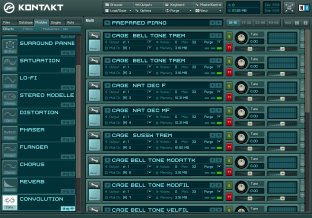The Piano as an Electroacoustic Instrument
Introduction
A piano’s physical size and shape has at times constrained a composer in the ability to rapidly and repeatedly transform the instrument’s timbre in a consistent and convenient manner. Non-traditional sounds on the instrument — bowing, scraping, or other prepared piano techniques (Cage) can be problematic to realize compositionally — or at least require extensive planning and rehearsing in advance of a performance.
As well, physical changes that must be applied to the instrument itself in order to realize these timbres often require the composer to take an approach that is either/or in nature. Piano strings are either treated (prepared) or left untreated. The rapid switching between the two (especially during performance) is for the most part impractical.
Real-time performance extensions and manipulations used by the electroacoustic composer such as granularization (Truax), hyper-instrument techniques (Machover), and other techniques commonly used in genres such as Intelligent Dance Music (IDM) and soundscaping, are not practical in performance given the instrument’s “traditional” design. As a result, with the exception of tape-based music, these “sonic colors and techniques” are often neglected or used more for ‘effects’ purposes.
[Re]construction of the Piano as a 21st Century Electroacoustic Instrument
With increasingly powerful computers — specifically laptops, there is now the ability for an electroacoustic composer to write for an “extended” instrument — one no longer dependent upon the instrument’s physical form.
Software applications (Native Instruments) allow the ability to stream large samples of the instrument (unaltered as well as transformed), while physical modeled instruments (Modaart) provide remarkably authentic piano re-productions that can in turn be manipulated at will.
Other timbres — such as prepared-piano, harmonics, and bowed piano can now be integrated easily as a whole,vand utilized effectively as compositional colors.
Different instrument “types” can overlap or be layered based on tempo or musical dynamics. Piano timbre can shift (seamlessly) from a prepared piano to bowed piano, or both instruments played simultaneously.
As well, techniques such as live sampling, re-synthesis and other manipulations can now be rendered in realtime. The result is an instrument — Piano 2.0 (to borrow an Internet term), that has been transformed. The instrument has been [re]constructed into something new, yet still immediately familiar.
Piano 2.0 — A Work in Progress

Using standard piano repertoire (Bach, Debussy, Cage, Stockhausen), material was initially performed using various software applications (Native Instruments, Cycling74). Various sample libraries (Native Instruments), (Big Fish), (Post Musical Instruments) were utilized for primary instrument samples (both source as well as prepared piano) — with personal recorded samples for instrument timbres not available commercially such as bowed piano, large piano tone clusters, cross-synthesis, etc.
Along with constructed sonic timbres, real-time performance techniques have been developed using the Kontakt Script Processor (KSP, Native Instruments) and MIDI-based patching applications for channel switching, triggering, etc. (Cycling74, SubtleSoft).

This formed the basis for the composite instrument that was developed.
With initial work complete, additional work was performed — refining the use and application of these tools, and integrating them with other software music applications (Ableton, Digidesign).
Further refinement of performance scripts, and the introduction of a physical modeled piano (Modaart) has reduced the computing resource requirements for the primary piano timbres, allowing greater reliability in the number of simultaneous instruments (and voices) available — especially during performance.
Work has most recently evolved to utilizing these tools and techniques for a series of electroacoustic
compositions for piano and voice, titled PianoVoce.
Results… “The Piano is Dead (Long live the piano)”
With the advent of the “laptop musician”, there is now a practical way to expand the sonic vocabulary of the piano as an instrument for the 21st century.
No longer bound by the instrument and its physical form (as the acoustic sound source), the electroacoustic
composer is able to “sculpt piano sound” — combining both the historical timbres of the instrument, and the new sonic landscape and timbres of its future.
The result has been a “new” form of piano where harmonics, prepared piano, granular tone clusters, and
whatever else can be imagined, all converge into a cohesive instrument.
References & Inspirations
Papers, Books
Boulanger, Richard. The Csound Book: Perspectives in Software Synthesis, Sound Design, Signal Processing,and Programming. The MIT Press, 2000.
Machover, Tod (principal investigator). Hyperinstruments — A Progress Report 1987–1991. MIT Media Laboratory. January 1992.
Roads, Curtis. Microsound. Cambridge, MA: MIT Press, 2002.
Rowe, Robert. Interactive Music Systems — Machine Listening and Composing, MIT Press, 1993.
_____. Machine Musicianship, MIT Press, 2001.
Seashore, Carl Emil. In Search of Beauty in Music, The Ronald Press Company, 1947.
Temperley, David. The Cognition of Basic Musical Structures, MIT Press, 2001.
Truax, Barry. “Composing with Real-Time Granular Sound.” Perspectives of New Music, 1990.
Winkler, Todd. Composing Interactive Music — Techniques and Ideas using Max, MIT Press, 1998.
Compositions, Artists
Aphex Twin. Drukqs, Warp Records, 1997.
Autechre. Tri Repetae, Warp Records, 1995.
BT. This Binary Universe, DTS Entertainment, 2006.
Cage, John. Sonatas and Interludes for Prepared Piano, 1946–1948.
Murcof (Corona, Fernando). Martes, The Leaf Label, 2002.
Truax, Barry. Digital Soundscapes — Computer and Electroacoustic Music by Barry Truax, Cambridge Street Records, 1987.
Software Applications
Native Instruments: Kontakt, Reaktor, Battery
Modaart: Pianoteq
Cycling74: Max/MSP
Digidesign: ProTools
Ableton: Live
Tom Erbe: Soundhack
SubtleSoft: MidiPipe
CSound: Various contributors, Open Source
Social top